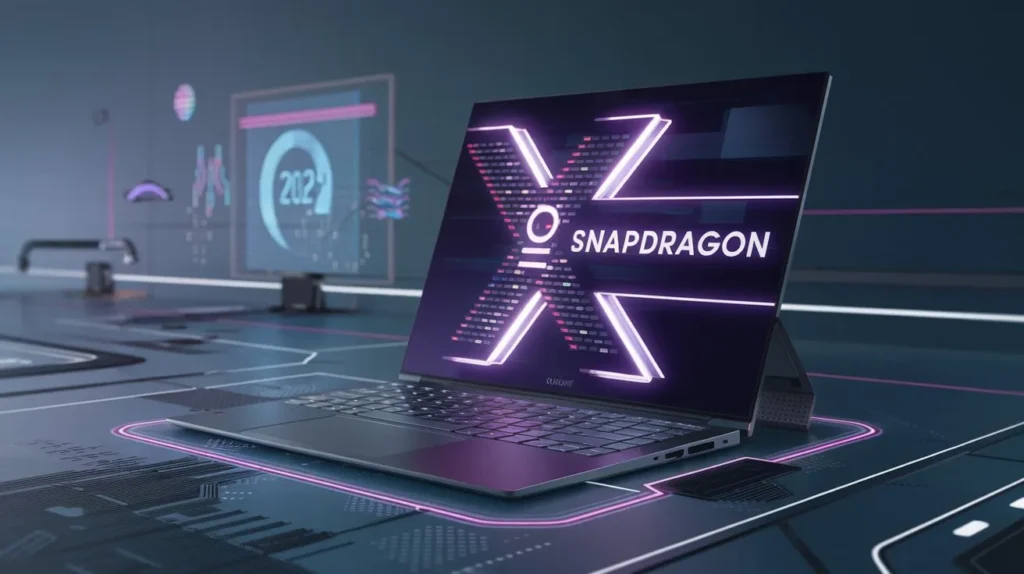Introduction
The Qualcomm Snapdragon X chip is set to revolutionize the PC market in 2025 by delivering affordable, high-performance laptops that directly compete with Intel and AMD. Building on the success of Snapdragon X Elite and X Plus in 2024, Qualcomm aims to make cutting-edge technology accessible to a broader audience. With improved ARM optimization, advanced AI capabilities, and efficient power usage, this innovation could transform the PC industry for budget-conscious users.
Table of Contents
The Journey So Far: Snapdragon X Elite and X Plus
In 2024, Qualcomm introduced the Snapdragon X Elite and X Plus, ARM-based processors that showcased exceptional efficiency, low power draw, extended battery life, and high-end performance. These chips were particularly impressive in handling AI tasks like video editing and image generation. They even supported casual gaming seamlessly, with integrated GPUs capable of running titles like GTA V.
However, despite their technological advancements, these chips struggled to gain significant market share due to their high price points. Laptops powered by Snapdragon X Elite started at ₹100,000 in India, while mid-range models hovered around ₹80,000–₹90,000. This limited their accessibility to a niche audience.
Enter Snapdragon X Chip: Affordable Innovation
To address these challenges, Qualcomm has introduced the Qualcomm Snapdragon X chip, designed specifically for affordable Windows laptops priced around ₹50,000–₹55,000. This move aims to make advanced technology accessible to students, office workers, and everyday users who need reliable performance without overspending.
Key Specifications:
- 8-core architecture (X1-2600) with a maximum clock frequency of 3GHz.
- 30MB cache for faster data processing.
- 45 TOPS AI performance, matching its premium predecessors like Snapdragon X Elite.
- Integrated GPU capable of handling basic gaming and AI tasks such as video editing or subtitle generation.
These specifications ensure that the Qualcomm Snapdragon X chip delivers a balance of performance and efficiency suitable for entry-level laptops.
Competing with Intel and AMD
The Snapdragon X chip directly challenges Intel Core i5-120U processors by offering better efficiency and benchmark performance. Built on a cutting-edge 4nm TSNC process, this chip ensures lower power consumption compared to Intel and AMD alternatives. This makes it ideal for thin-and-light laptops that prioritize extended battery life—something often missing in budget-friendly devices.
Why Efficiency Matters:
- Lower power draw translates to longer battery life.
- ARM-based architecture enables seamless multitasking without overheating.
- Students and professionals can enjoy uninterrupted productivity throughout the day.
ARM Optimization: A Game-Changer for Snapdragon
One of the biggest hurdles faced by ARM processors was limited app compatibility. Many popular software applications were designed for x86 architecture, making them inefficient or unusable on ARM-based devices. However, by 2025, Qualcomm has made significant progress in overcoming these limitations:
- ARM Versions of Popular Apps: Developers have increasingly optimized their software for ARM processors. This includes productivity tools like Microsoft Office, Adobe Creative Suite, and even gaming platforms.
- Advanced Emulation Technology: Qualcomm has improved its Prism emulation system to seamlessly translate x86 apps into ARM architecture. This ensures smooth performance across legacy applications.
- Collaborations with Microsoft: Microsoft has enhanced its support for ARM-based devices through initiatives like Co-Pilot Plus integration.
These advancements make the Qualcomm Snapdragon X chip more versatile than ever before.
Industry Adoption: Major Brands Join the Revolution
Leading PC manufacturers such as HP, Lenovo, and Dell have announced plans to launch laptops powered by the Snapdragon X chip. These devices promise to deliver long battery life, AI-enabled features like Microsoft’s Co-Pilot Plus, and an overall quality experience at affordable prices.
Why Co-Pilot Plus Matters:
Microsoft’s Co-Pilot Plus allows users to perform AI tasks offline—without internet connectivity. Features include:
- Generating subtitles for videos.
- Creating images using AI tools in Microsoft Paint.
- Performing video editing with AI assistance.
These capabilities make Snapdragon-powered laptops highly appealing to users seeking advanced functionality at a lower cost.
Addressing Budget Laptop Challenges
Affordable laptops under ₹50,000 often compromise on key features such as battery life and overall performance. Qualcomm addresses these issues with the Snapdragon X chip by focusing on:
- Long-lasting battery life for uninterrupted productivity.
- AI capabilities for offline tasks that enhance creativity and efficiency.
- Integrated GPUs for casual gaming without external graphics cards.
This combination makes the Snapdragon-powered laptops a compelling choice for budget-conscious users seeking advanced technology without sacrificing quality.
The Future of AI PCs: A Competitive Landscape
The rise of AI-enabled laptops powered by ARM processors signals an exciting time for the PC industry. Competitors like AMD and NVIDIA are also working on ARM-based chips with enhanced AI focus. This competition will likely accelerate innovation across the board.
Key Trends to Watch:
- Increased adoption of ARM technology in mainstream laptops.
- Enhanced support for AI-driven tasks across productivity tools.
- Greater emphasis on energy-efficient designs that reduce environmental impact.
As Qualcomm continues to refine its technology, we can expect more affordable devices that challenge Intel and AMD’s dominance in this segment.
Conclusion: A Bright Future for Affordable PCs
The Qualcomm Snapdragon X chip is poised to disrupt the affordable PC market in 2025 by delivering efficiency, performance, and AI capabilities at a competitive price point. With improved ARM optimization and growing industry adoption from major brands like HP and Dell, Qualcomm has a real chance to challenge Intel and AMD’s dominance in this segment.
Will you choose a Snapdragon-powered laptop, or stick with traditional Intel or AMD options? Let us know your thoughts!




